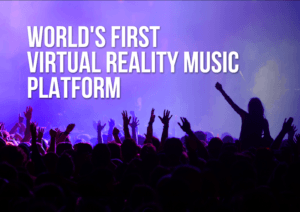VRTIFY: The World’s First Virtual Reality Music Platform

ABOUT
VRTIFY is a music platform where users can create, upload, share, and consume VR music-related content. With more than 5,000 hours of live concerts, interviews, and video clips available, VRTIFY gives users the opportunity to immerse in music content and engage with artists through virtual and mixed reality.
See VRTIFY’s Main Features Here

VALUE CREATION MODEL
End users are both consumers and suppliers of all content on VRTIFY. There are currently three features through which consumers can interact with VRTIFY’s platform:
VR Videos – Consumers watch VR video clips uploaded by artists and other users. Imagine watching your favorite band perform at a concert thousands of miles away! Additionally, using mixed reality (better known as augmented reality), consumers can integrate VR clips with their surroundings, making it seem as if a concert is being played right in the living room.
- VR Music – Consumers watch VR non-music content (e.g. a VR clip of a boat ride down the Amazon river) while listening to music on existing music platforms such as Spotify and Pandora.
- VR Channels – Consumers access batches of VR content curated by music groups and artists, but unlike VR Videos, VR channels include content such as up-close interviews with a band. Think YouTube video blogs, except in VR.
 By aggregating VR music and video clips onto one platform, VRTIFY creates value for consumers by not just enhancing people’s music-listening experiences but also making it convenient for consumers to search for VR music-related content. Another cornerstone to VRTIFY’s value creation model is that it’s extremely accessible! VRTIFY is available on every device and platform (VR headsets, MR Goggles, Web, Mobile, and Smart TVs) and can be used with all of the major digital music service providers — Spotify, Deezer and SoundCloud.[1]
By aggregating VR music and video clips onto one platform, VRTIFY creates value for consumers by not just enhancing people’s music-listening experiences but also making it convenient for consumers to search for VR music-related content. Another cornerstone to VRTIFY’s value creation model is that it’s extremely accessible! VRTIFY is available on every device and platform (VR headsets, MR Goggles, Web, Mobile, and Smart TVs) and can be used with all of the major digital music service providers — Spotify, Deezer and SoundCloud.[1]
For content creators such as artists and music/VR film producers, VRTIFY’s proprietary end-to-end technological stack makes it easy to create, manage, and distribute VR video clips or channels. The clip can either be music-related (e.g. a concert) to support VRTIFY’s VR Videos feature or non-music-related (e.g. a helicopter ride around an island) to support the business’ VR Music and VR Channels features. VRTIFY’s technological stack includes video and sound recording software & equipment, VR editing & rendering tools, VR streaming technology, social tools for sharing, and an SDK to generate digital ambiances & augmented reality.[2]
Finally, VRTIFY’s platform allows Advertiser and Brands to target a specific audience segment, manage their budget, and access analytics to monitor an advertisement’s performance.[3]
VALUE CAPTURE MODEL
Much like Spotify, VRTIFY has stated that it will operate a freemium business model. Thus, revenue will come in the form of advertisement fees, to support VRTIFY’s free-tier product, and Premium subscription fees, to support VRTIFY’s ad-free product. It is not yet known whether VRTIFY will offer any additional benefits to premium-tier customers, as the company only just released a beta version of its product last year. Also like Spotify, 70% of VRTIFY’s revenues are distributed to Artists and Content Owners ($0.026 per 1.000 views projected by 2019).[4]
RECOMMENDATIONS
Like all VR platforms, VRTIFY faces a classic chicken-and-egg problem. However, by curating its own content and offering a platform in which essentially anyone can submit a VR clip, it has already accumulated over 1,000 videos. In fact, I think VRTIFY is right to focus on the supply-side of the platform, at least for now. VR hardware is still being refined and adoption rates are low. Moreover, little-to-no VR music platforms currently exist. VRTIFY should partner with VR headset manufacturers and distributors by allowing them to use the VRTIFY brand. Hardware players will benefit from the ability to offer one more feature to attract end-users to purchase their product and VRTIFY will benefit from the marketing.
Hence, my advice to VRTIFY is simple: large companies such as Google, Samsung, and Facebook have deep pockets and will already be spending A LOT on marketing campaigns to acquire customers – let them. Focus on creating the best VR music platform technology and building a large library of excellent VR clips so that HMDs will want to do your marketing for you.
Additional recommendations are as follows:
Short-term (0-1 years)
- It’s all about the product. As previously mentioned, until better and more affordable VR HMDs exist, VRTIFY should focus on (1) curating and sourcing excellent VR content and (2) developing a great technological platform. Specifically, VRTIFY should implement mechanisms to streamline the VR content vetting process. Additionally, VRTIFY should use machine learning and artificial intelligence to recommend VR content to users.
- Clarify the payment model and video selection process. Currently, it is unclear whether any individual who submits content will be able to earn money. I assume this will not be the case, since this would be a logistical nightmare (consider what if YouTube decided to pay everyone who uploaded content). In this case, how will VRTIFY select which video clips are featured on the platform?
- Create a community of evangelist users to test product features and provide feedback. VRTIFY should at least create a blog on its website to keep evangelist users posted of any updates as it rolls out new features. Additionally, I would recommend creating a portal for VRTIFY’s biggest fans whereby individuals can participate in surveys and pilot features before they are released.
Medium-term (1-5 years)
- Create a superior analytics platform for advertisers and charge them to access premium product features. VRTIFY would be wise to take note from the likes of companies such as Spotify and Pandora, both of which have yet to demonstrate a sustainable business model. Since most users on VRTIFY will be free-tiered users, VRTIFY should provide basic, premium, and professional packaged analytics solutions to advertisers.
- Monetize on live music performances. Currently, consumers cannot watch concerts in real-time. Potential competitors in this space include NextVR, which recently formed a partnership with Live Nation. However, there is room for VRTIFY to partner with AEG Live, which puts on music festivals such as Coachella. Enabling customers to stream into a concert via VR would be a tremendous revenue generating opportunity for VRTIFY, since most individuals are accustomed to paying for concerts and other live events.
Long-term (5+ years)
- Provide different benefits to paid-tier users and clearly identify these differences on VRTIFY’s website. To attract users, VRTIFY should start out by keeping the differences between its premium and free tiers at a minimum. However, as the company scales and adds new features, it should be deliberate about which features to offer to just paid users. Indeed, Spotify is only just realizing that it may need to offer greater benefits to paid users to increase the conversion rate of free-to-paid users. Doing so not only helps Spotify’s bottom line but also keeps labels and publishers happy (and may even incentivize them to lower their royalty rates).
- Partner with companies to create premium branding opportunities. As VR hardware becomes more widely adopted, VRTIFY should look for ways to partner with organizations, and not just consumers, similar to Spotify’s corporate partnerships with companies like Uber and Starbucks. For instance, partnering with airlines would provide yet another opportunity for VRTIFY to monetize its platform.
RESOURCES
[1] https://www.vrtify.com/about
[3] https://www.vrtify.com/about
[4] https://www.vrtify.com/about
http://www.bbc.com/news/business-38795190
https://www.crunchbase.com/organization/vritify#/entity
https://www.funderbeam.com/startups/vrtify?ref=teleport
http://fortune.com/2016/01/07/umg-iheartmedia-partner-on-vr/
http://variety.com/2015/digital/news/vrtify-virtual-reality-music-video-1201626499/


